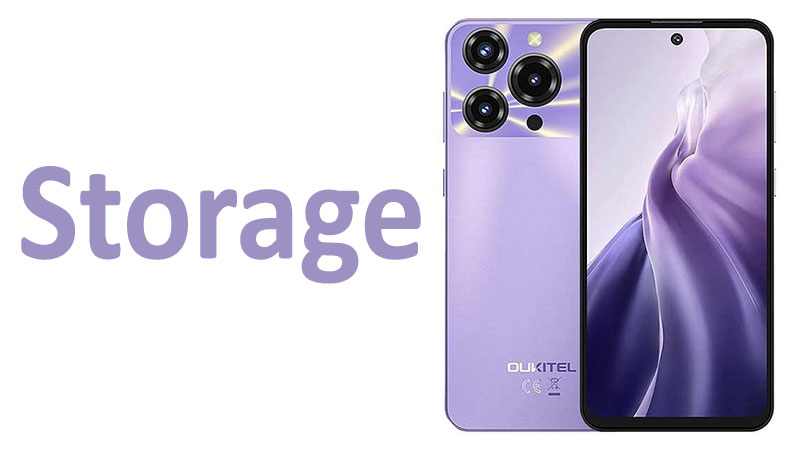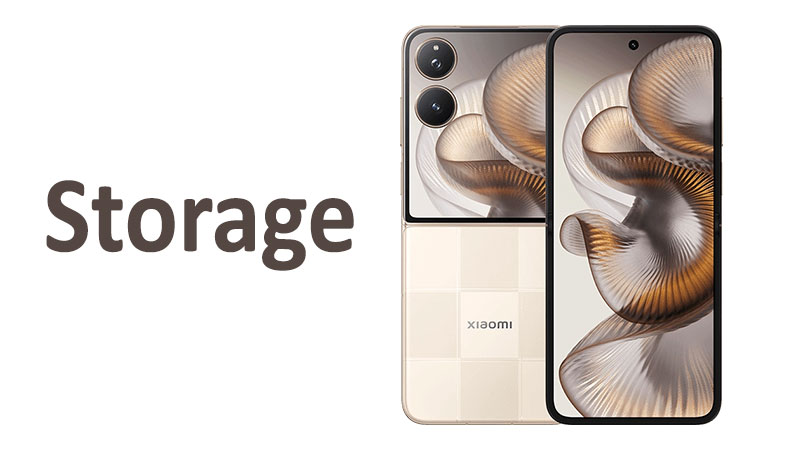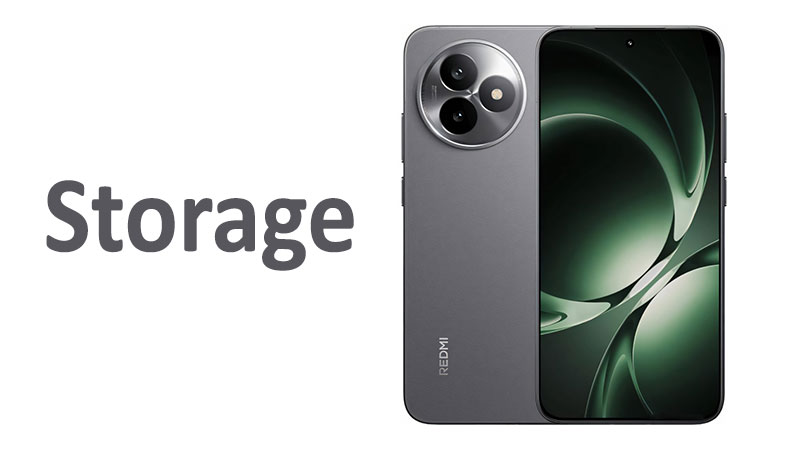Oukitel C69 storage is a defining feature that impacts the user experience. Understanding its capacity and limitations is essential before buying. This detailed guide explores the 128GB internal capacity thoroughly. It also examines the 4GB RAM configuration. We will discuss the expandable storage options available. Furthermore, we will explain the trade-offs typical of budget smartphones. This analysis will help readers make a well-informed decision.
Capacity: 128GB Internal Storage Explained
The Oukitel C69 comes standard with 128GB of internal storage. This is a respectable capacity for a budget-friendly smartphone. It represents a significant improvement over older 64GB or 32GB models. The 128GB capacity offers considerable room for data. Users can store a wide array of applications and files. This base level of storage is often sufficient for daily mobile needs.
The Standard 128GB Offering
This storage level is considered the current industry standard. Most modern operating systems require a substantial amount of space. The 128GB figure remains appealing to many consumers. It balances capacity with the device’s lower price point. This provides value without forcing users into cloud-only solutions. The Oukitel C69 storage gives users a great starting point.
Remember that the system files consume some space. The Android operating system takes up about 10GB to 15GB. Pre-installed applications also use a small portion of the total. Therefore, the actual usable storage will be slightly less than 128GB. Buyers should expect roughly 110GB to 115GB of free space immediately available.
Daily Use Scenarios for 128GB
The 128GB internal capacity handles common daily tasks easily. Users who primarily browse the web will find it more than enough. It supports streaming video services like Netflix and YouTube smoothly. Messaging applications like WhatsApp and Telegram take up minimal space. Standard apps like maps and banking tools install quickly and efficiently.
This capacity suits casual photography enthusiasts well. It can hold tens of thousands of standard-resolution photos. It accommodates a decent library of high-definition videos. Users who occasionally record short video clips will rarely face storage issues. This means less worry about constantly deleting older memories. This capacity is highly convenient for general daily use.
Handling Media and High-Demand Apps
Mobile gaming is one area where storage demands increase quickly. Many popular games now require several gigabytes of space each. A 128GB capacity can handle a small library of these large titles. Dedicated mobile gamers, however, might fill this space quickly. They should plan to utilize the expandable storage option.
Heavy video recording also consumes storage rapidly. Recording 4K video is highly data-intensive. Even high-resolution 1080p footage can quickly deplete the available space. Users who create significant amounts of media content must manage their files. They should frequently transfer data off the phone or use cloud services. The 128GB is a generous baseline, but it has limits.
The Role of 4GB RAM in C69 Performance
The Oukitel C69 storage is paired with 4GB of RAM. RAM is critical for multitasking and application performance. It allows the phone to quickly access data for active programs. The 4GB capacity is the minimum standard for smooth Android operations today. It directly influences how many apps can run simultaneously.
RAM and Multitasking Limits
With 4GB of RAM, the Oukitel C69 handles essential multitasking effectively. Users can comfortably switch between two or three active applications. For example, moving from a browsing session to a messaging app is smooth. However, the system may struggle with more demanding use cases. Running a graphics-heavy game alongside a navigation app can strain the memory.
The phone will aggressively close background apps to free up space. This process is known as memory management. It ensures that the current foreground app runs reliably. However, it means previous background apps must reload when you switch back. This reloading introduces a slight delay in the user experience.
Synergy with Internal Memory
The internal 128GB storage works closely with the 4GB RAM. When RAM runs out of space, the phone uses a form of virtual memory. It uses a portion of the internal storage to temporarily hold data. This process is slower than using dedicated RAM. A slower internal memory, typical of budget phones, exacerbates this delay.
Therefore, the combination is important for overall speed. The 4GB RAM is the bottleneck in this configuration. Even with fast internal storage, the RAM capacity limits multitasking depth. This setup is optimized for efficiency and cost. It is a common trade-off in the budget smartphone category.
Specialized Comparison: 4GB RAM vs. 6GB
Comparing 4GB RAM to the 6GB found in slightly higher-priced competitors reveals a difference. A 6GB RAM model offers a noticeable boost in retained background apps. It minimizes the aggressive closure of unused programs. This results in a smoother, more seamless transition between tasks.
The 4GB RAM in the Oukitel C69 is focused on foundational stability. It ensures core functions run reliably. The phone performs well for its class and price. However, users of the 4GB model must be mindful of running too many heavy apps. They should manually close applications they are finished using. This simple habit preserves system speed and stability.
Storage Technology Profile: Speed and Type
The speed of the internal storage is as crucial as its capacity. While the Oukitel C69’s specific storage type is not always advertised, it is critical. Budget smartphones in this configuration typically use eMMC technology. eMMC stands for embedded MultiMediaCard. This technology is highly cost-effective and reliable.
Speed Profile of Budget Storage
eMMC is generally slower than the newer UFS standard. Its read and write speeds are considerably lower. This affects several key areas of phone operation. Application installation times are longer with eMMC storage. Large file transfers also take more time to complete. The phone’s boot-up process is another area affected by slower speeds.
This technology operates using a simpler data bus structure. This is why it remains popular in the budget sector. However, users should expect a slight pause when launching heavy apps. The storage speed ensures consistent, reliable access, but not blazing-fast performance. This is an expected compromise given the Oukitel C69’s price point.
Comparison: C69 Storage Speed vs. UFS
UFS (Universal Flash Storage) is the superior, faster technology. It is found in mid-range and premium smartphones. UFS offers significantly higher sequential and random speeds. The Oppo F31, for example, uses UFS 2.2, which is notably faster. UFS uses a dedicated command queue for simultaneous data operations.
eMMC storage, by contrast, handles operations sequentially. It cannot read and write data at the same time efficiently. This difference creates a noticeable performance gap. The Oukitel C69’s storage is perfectly functional for basic tasks. However, it will not offer the instantaneous feel of a UFS-equipped device. Buyers must temper their speed expectations accordingly.
Impact on the User Experience
The storage speed primarily impacts system responsiveness. A faster system is evident in daily interactions. Slower storage means app updates take longer to download and install. Large photos and videos take a moment longer to save after capture. General file management operations, like copying data, are slower.
Despite the eMMC limitations, the experience remains highly usable. The C69’s software is typically optimized for this hardware. The phone delivers a stable and predictable user experience. Users accustomed to older devices will notice little difference. Those upgrading from flagship phones will observe a clear difference in speed. The phone still performs all necessary functions reliably.
Storage Expansion: microSDXC Card Slot Utility
The Oukitel C69 offers expandable storage via a microSDXC card slot. This feature is highly beneficial for budget smartphone users. It provides a flexible way to add massive amounts of storage. This can easily double or triple the phone’s total capacity. Users can carry entire media libraries without paying for internal storage upgrades.
The Shared SIM Slot Limitation
The card slot configuration is a key detail for buyers. The Oukitel C69 uses a shared SIM slot for expansion. This means the user must choose between two options. They can use two SIM cards for dual network connectivity. Alternatively, they can use one SIM card and one microSDXC card. This is known as a hybrid or shared slot configuration.
This limitation requires a clear decision from the user. If they require a second phone number, external storage is unavailable. If large storage is prioritized, they must forgo the second SIM card. This is a crucial compromise for users who rely on both features. It is a common design choice to save space and cost in budget models.
Benefits of External Capacity
The primary advantage of the microSDXC slot is its cost-effectiveness. High-capacity memory cards are inexpensive to purchase. They provide a cheap way to increase storage by up to 1TB or more. This allows users to offload large files from the internal 128GB memory. This strategy frees up the internal storage for faster app execution.
External storage is also beneficial for media portability. Users can easily remove the card to transfer files to a computer. This makes backing up photos and videos very straightforward. It also allows for quick media sharing between compatible devices. The expandable storage is a great resource for data management flexibility.
Choosing the Right Expansion Card
Not all microSDXC cards offer the same performance. Choosing a slow card can severely impact the user experience. It can cause stuttering when playing high-resolution media from the card. It may also slow down the camera when saving video. Therefore, users should invest in a fast, high-quality card.
Look for cards rated as Class 10 and UHS Speed Class 3 (U3). A V30 rating is best for video recording. These specifications guarantee fast read and write speeds. This ensures media files load quickly and reliably. Avoid generic or unrated cards to prevent future performance headaches. A quality card optimizes the C69’s expandable storage function.
Pros, Cons, and Key Considerations
The Oukitel C69’s storage and memory configuration presents a balanced offering. It provides significant advantages for its price point. However, users must be aware of its inherent limitations. Understanding these points helps align expectations with reality.
Pros of the Oukitel C69 Storage
The 128GB internal capacity is a major advantage for this class. It minimizes the immediate need for a separate memory card. The inclusion of a microSDXC slot provides excellent flexibility. This allows users to decide their own capacity needs later. The 4GB RAM ensures stable, functional performance for essential tasks.
The overall configuration offers a high value proposition. It is a dependable system for everyday communication and light entertainment. The 128GB of storage is ample for the target user demographic. This combination of capacity and expansion is a strong selling point.
Cons and Trade-Offs
The primary drawback is the use of slower internal storage technology. This leads to slightly longer loading times compared to mid-range phones. The 4GB RAM capacity limits intense multitasking capabilities. Users who jump between many apps will experience noticeable reloads.
The shared SIM slot is a necessary compromise. It forces the user to choose between dual-SIM functionality or storage expansion. This is the most significant design trade-off. Buyers must be prepared to accept one or the other. This limitation is a common feature in budget mobile devices.
Important Buyer Insights
Buyers should prioritize their usage needs clearly. If you require two different network providers, you cannot use a microSD card. If you need maximum storage for media, you must use only one SIM card. This choice is unavoidable with the C69’s shared slot design.
Always purchase a quality, high-speed microSD card if you choose expansion. Do not compromise on card speed to save a small amount of money. The performance difference between fast and slow cards is highly noticeable. Finally, remember to routinely clean up unused background apps. This simple maintenance optimizes the 4GB RAM system.
The Oukitel C69 Storage Buyer’s Guide
Selecting the Oukitel C69 requires a practical approach. Its configuration is designed for the value-conscious consumer. This guide offers final advice on how to decide if this phone is right for you. It helps manage expectations for long-term use.
Identifying Your Storage Persona
Consider if you are a light, moderate, or heavy user. A light user primarily messages and browses. The 128GB is perfect for this type of usage. A moderate user takes many photos and plays a few casual games. They will likely need a high-capacity microSDXC card.
A heavy user requires faster storage and more RAM. This group consists of serious mobile gamers and professional content creators. The Oukitel C69 may not meet their extreme performance demands. Heavy users should consider phones with UFS storage and 6GB or 8GB of RAM. The C69 is best suited for light to moderate usage profiles.
Managing Limited RAM and Storage Speed
Users must adopt smart habits to maximize the C69’s performance. They should avoid installing unnecessary applications. Regular maintenance, such as clearing app caches, is beneficial. This frees up space and ensures system stability. Use a good file manager to organize media and move it to external storage.
For the best app performance, use only one primary app at a time. Close resource-intensive programs when finished. This keeps the 4GB RAM clear for your current task. Understanding and working within the phone’s limitations ensures a smooth experience. The C69 rewards users who practice good device management.
Long-Term Usage and Value
The Oukitel C69 offers excellent long-term value. The 128GB of storage is large enough for several years of average use. The ability to expand storage further increases its lifespan. While the internal speed is not cutting-edge, it is consistent.
The phone’s main limitation, the 4GB RAM, may feel restrictive eventually. Future apps will demand more memory over time. However, for a budget phone, this configuration offers a great balance. It serves as a reliable, cost-effective device for communication and everyday tasks. This makes the Oukitel C69 a smart, low-cost investment.
Conclusion
The Oukitel C69 storage and memory configuration is an intelligent budget offering. The 128GB internal storage capacity is generous and functional. It is perfectly complemented by a dedicated microSDXC card slot for expansion. This allows users to manage their data needs affordably. The 4GB RAM provides sufficient power for core tasks and light multitasking.
While the internal storage technology is likely eMMC, its performance is reliable. It delivers a stable user experience, though it lacks the speed of UFS-equipped rivals. Buyers must understand the shared SIM slot limitation clearly. The choice between dual-SIM capability and expandable storage is necessary. For the budget-conscious user, the Oukitel C69 provides exceptional value. Its storage system is robust and adaptable for most everyday usage. This makes it a compelling choice in the value segment of the smartphone market.
Frequently Asked Questions (FAQ)
Is 128GB of internal storage enough for the Oukitel C69?
Yes, 128GB is ample for most average users. It holds many apps, photos, and standard-definition videos without issue.
Does the Oukitel C69 have a dedicated slot for a memory card?
No, the Oukitel C69 uses a shared slot. You must choose between inserting a second SIM card or a microSDXC card.
What kind of performance does 4GB of RAM offer on this phone?
The 4GB of RAM offers stable performance for essential apps. It is suitable for light multitasking but may cause reloads with heavy use.
Is the Oukitel C69 storage faster than UFS storage?
No. The C69 likely uses eMMC storage, which is slower than the UFS standard found in more expensive phones.
Should I install apps on the microSDXC card?
No, you should install apps on the faster internal 128GB storage. Reserve the microSDXC card for media files like photos and music.



